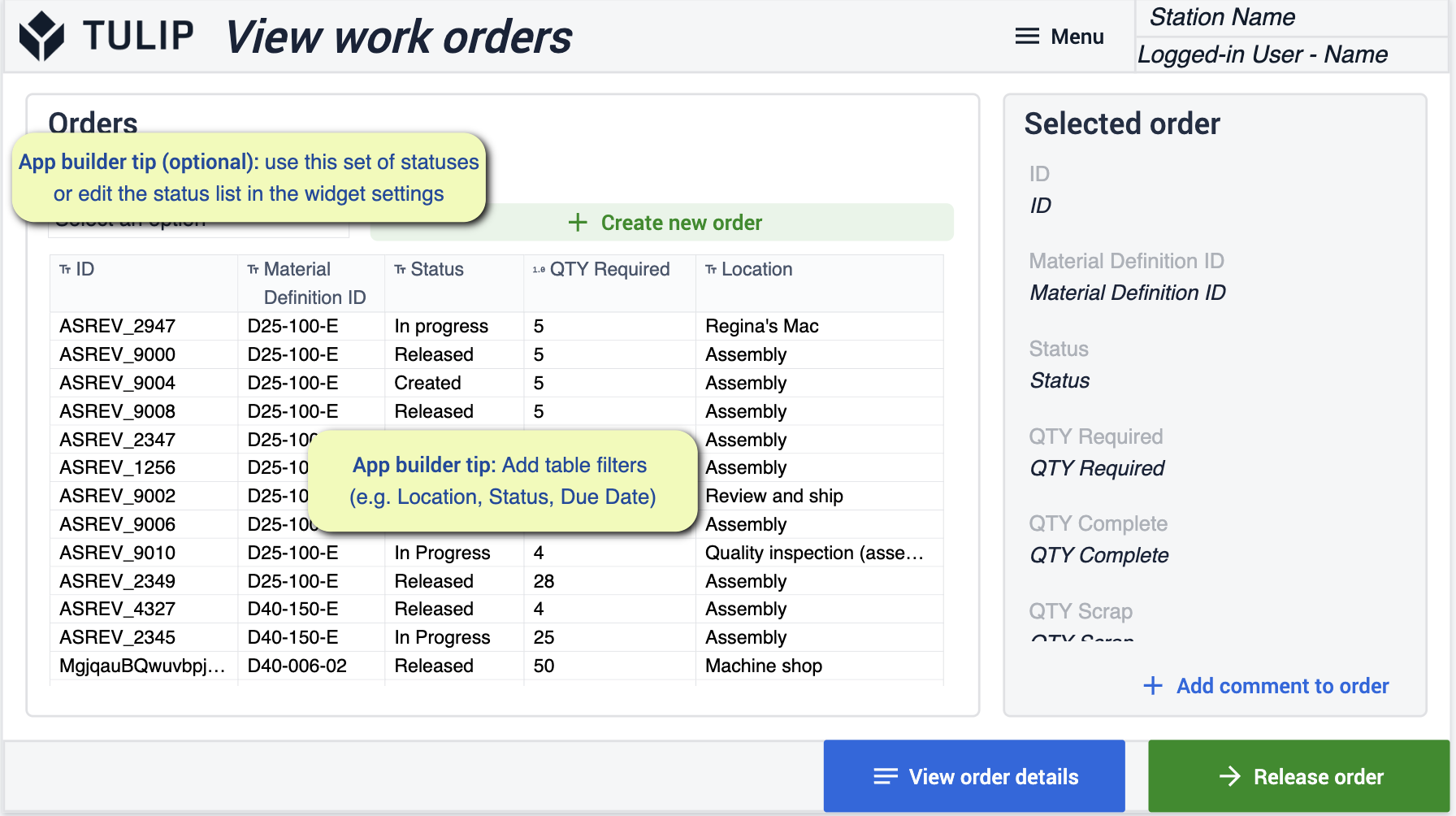质量应用程序套件为您提供了开始管理检验和质量相关行动的正确工具。确保您了解与质量相关的指标,从而提高产量。
前提条件
在此应用程序套件中,将有各种应用程序生成器提示供您参考。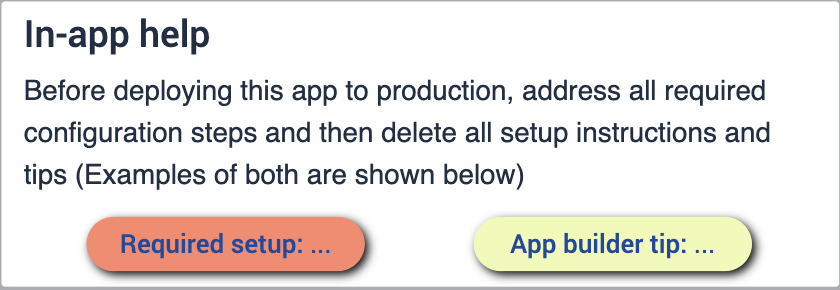
在配置应用程序套件之前,请确保您熟悉以下技能:
部署
您需要确保正确理解如何将这些应用程序部署到所需的设备上,以及如何在站点上运行这些应用程序。了解业务流程非常重要。有了车间的示意图,您就能在部署过程中更好地了解应用程序的位置。
连接的表格
您在整个应用程序套件中使用的表格将在您的各种应用程序中使用和连接。这样,您就可以获得更轻松的用户体验,并建立一个可用于开发未来应用程序的表格网络。了解更多有关表格如何通过使用通用数据模型最大限度地减少冗余和提高兼容性的信息。
下载
点击质量管理应用程序套件链接。这将带您进入库页面,您可以在此将应用程序添加到您的实例中。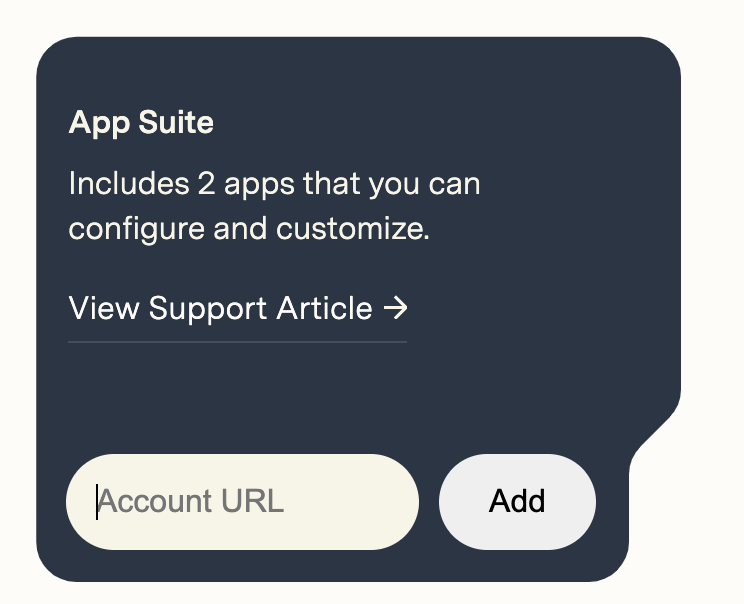
添加应用程序套件后,您会在实例中发现一个名为 "质量管理 "的文件夹。您可以在此查看套件中的所有应用程序。
质量管理
该应用程序套件的目的是通过全面了解检查流程,帮助您更好地处理业务中不同的质量问题。您从这里获得的价值主要集中在改进质量控制流程,提高可追溯性,了解低质量的成本,并做出数据驱动的决策。此外,还能更好地了解操作员、工位、产品等方面的缺陷。
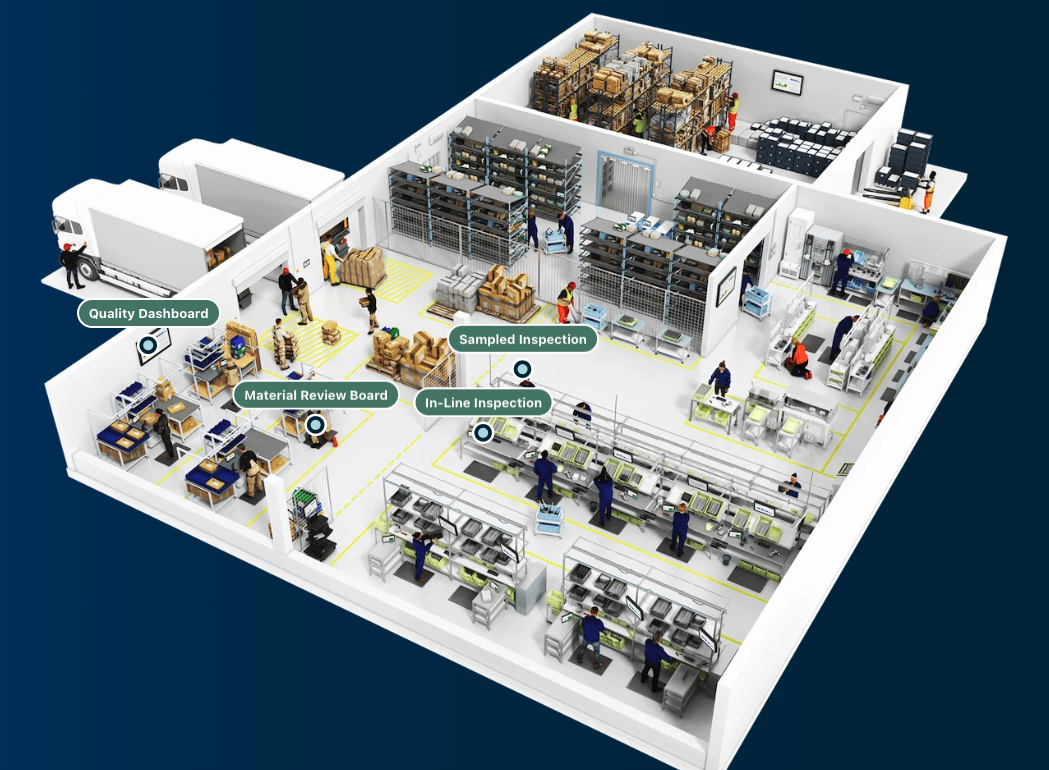
配置应用程序
While configuring applications, any changes made to tables need to be made across all applications for connectivity.
缺陷管理
在此应用程序中,您可以监控和报告缺陷事件。组织缺陷事件并提供适当的返工详情。
审查缺陷
您可以在此查看车间记录的所有缺陷。选择您希望深入了解的缺陷事件。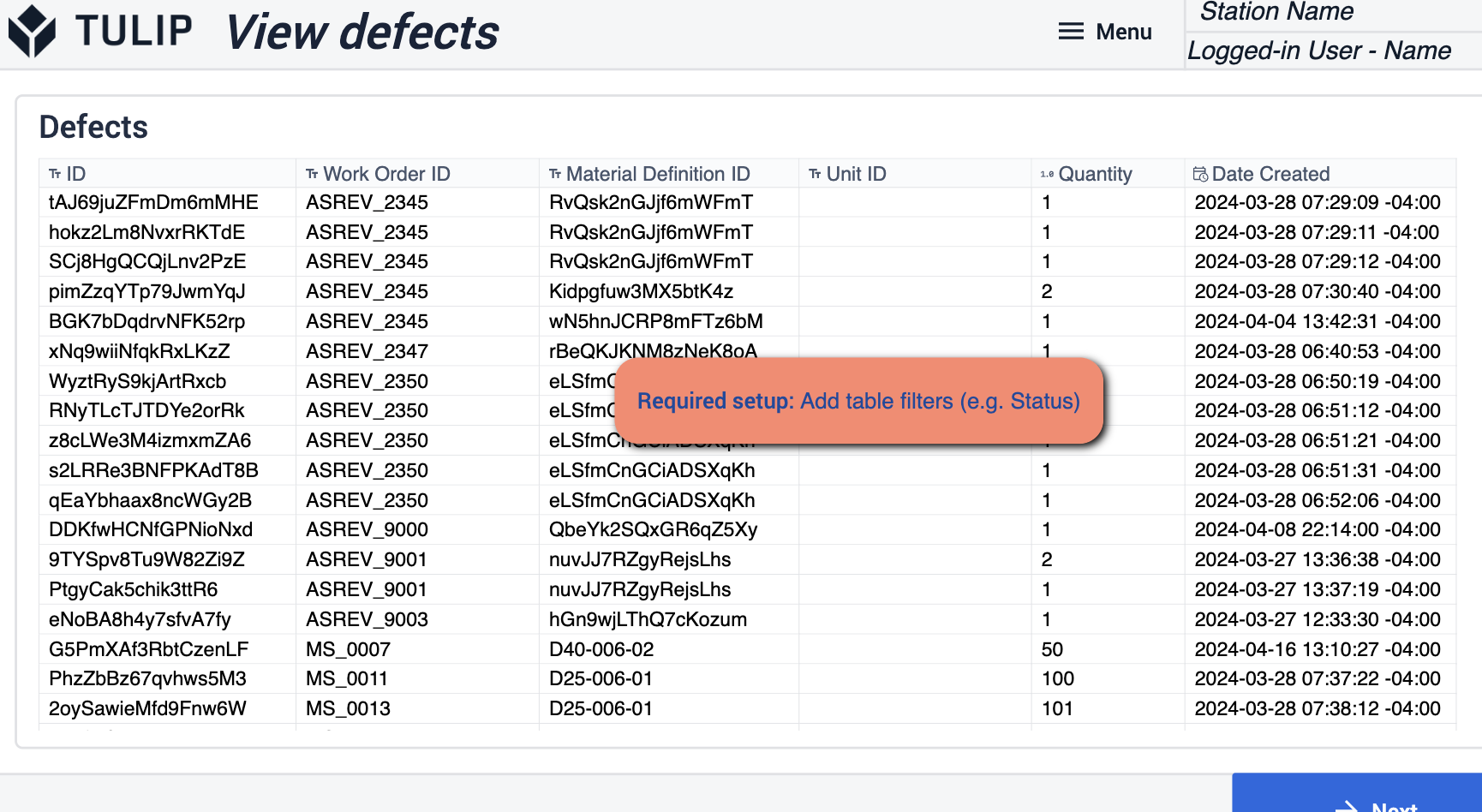 {height="300 "width=""}*此步骤所需的更改主要是为郁金香表添加过滤器
{height="300 "width=""}*此步骤所需的更改主要是为郁金香表添加过滤器
管理缺陷单位
通过此步骤,您可以查看和管理属于所选缺陷的特定详细信息。选择与事件状态相匹配的处置。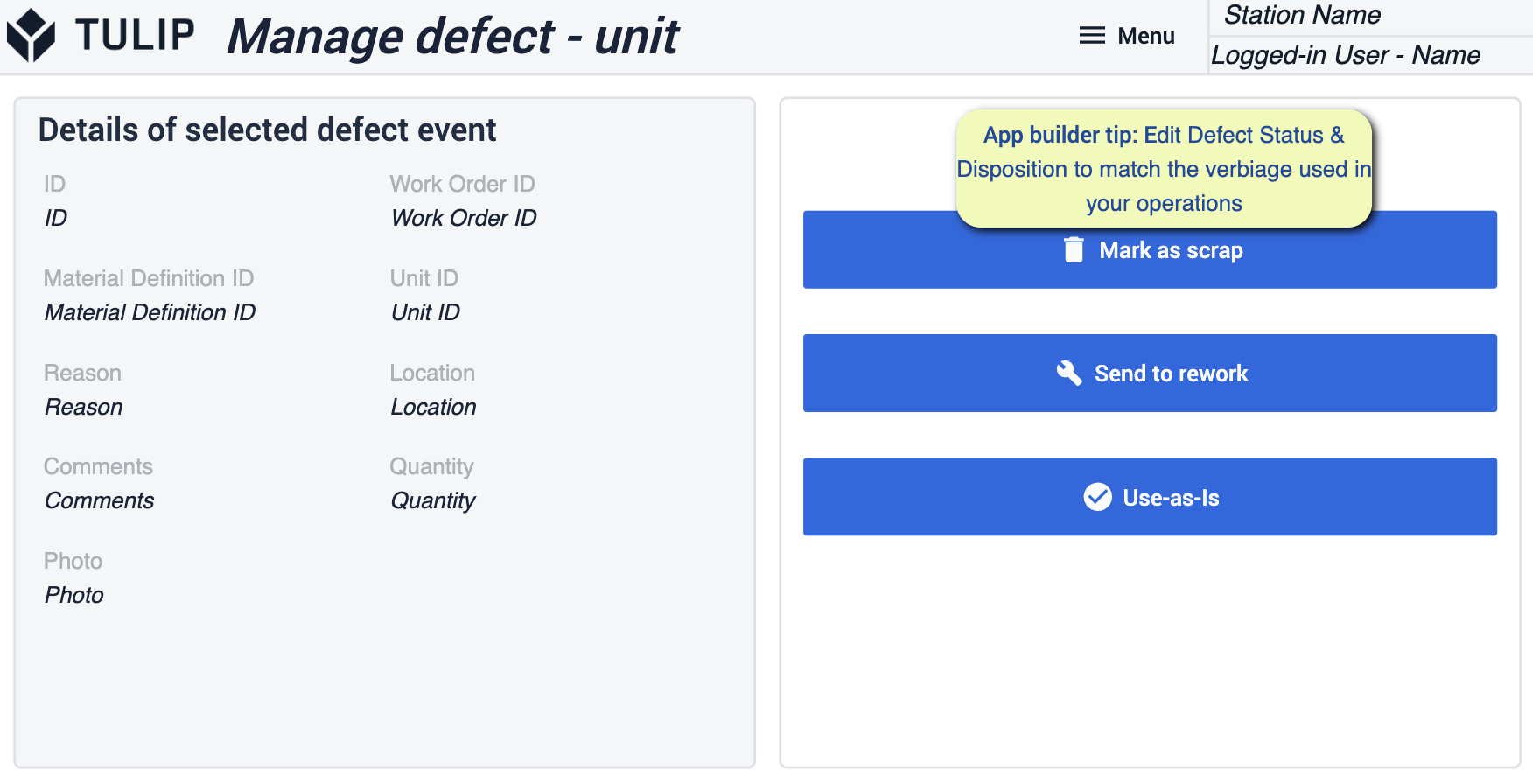 {height="300" width=""}* 应用程序生成器小贴士,编辑缺陷和处置以匹配设施使用的语言。
{height="300" width=""}* 应用程序生成器小贴士,编辑缺陷和处置以匹配设施使用的语言。
批量管理缺陷
此步骤不同于缺陷管理,更适合批处理,但遵循相同的原则。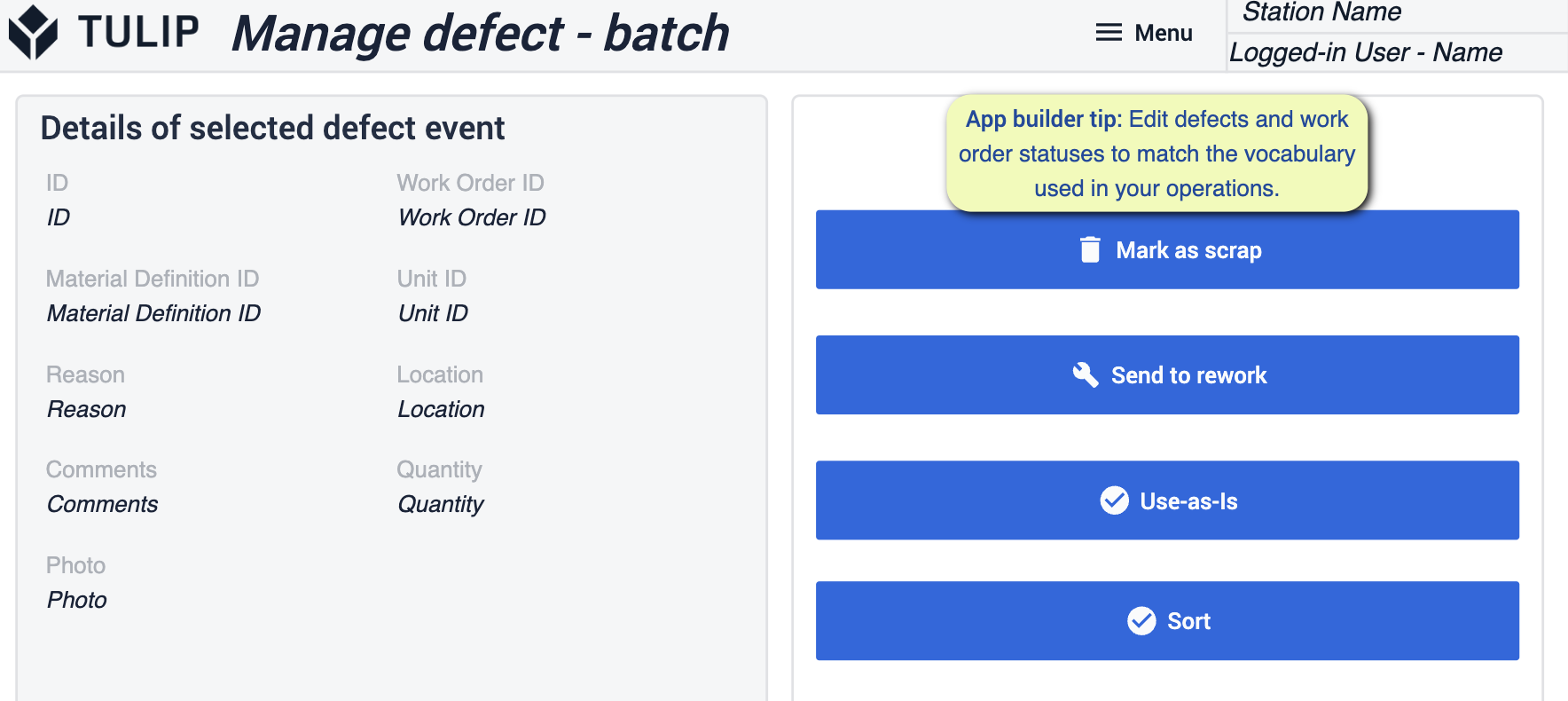
返工详情
在这一步,你将记录返工是成功还是失败,并提供缺陷注释。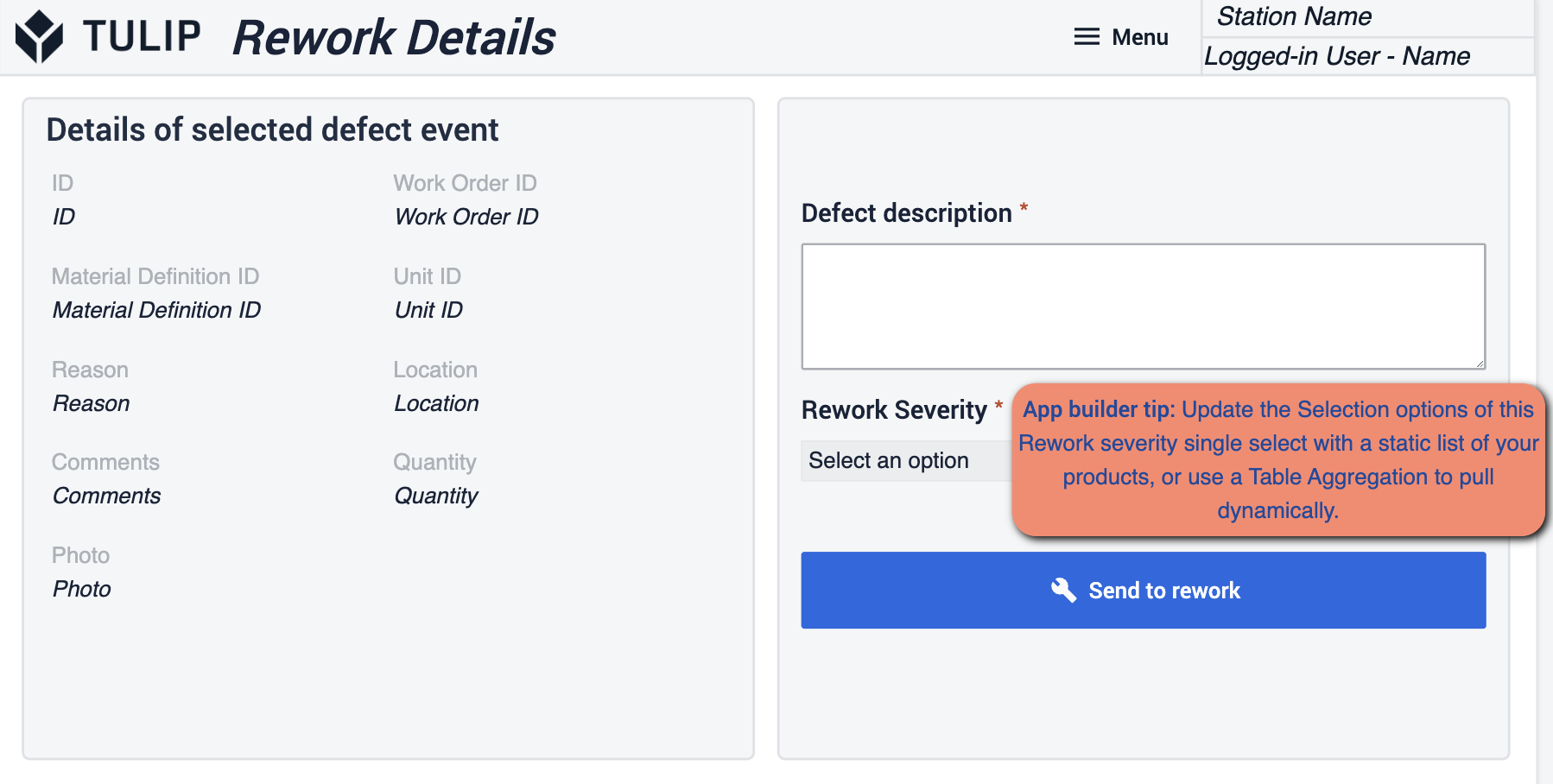 {height="300" width=""}* 你要确保更新返工的选择选项。您可以更改静态值,使其与您的操作相匹配。
{height="300" width=""}* 你要确保更新返工的选择选项。您可以更改静态值,使其与您的操作相匹配。
质量管理仪表板
质量控制面板应用程序可让您深入了解全天记录的信息。您可以实时了解发现了多少缺陷以及解决这些缺陷所需的时间。
质量控制面板
这一步将提供任务本身的视图。显示关键指标的实际数字和图表。
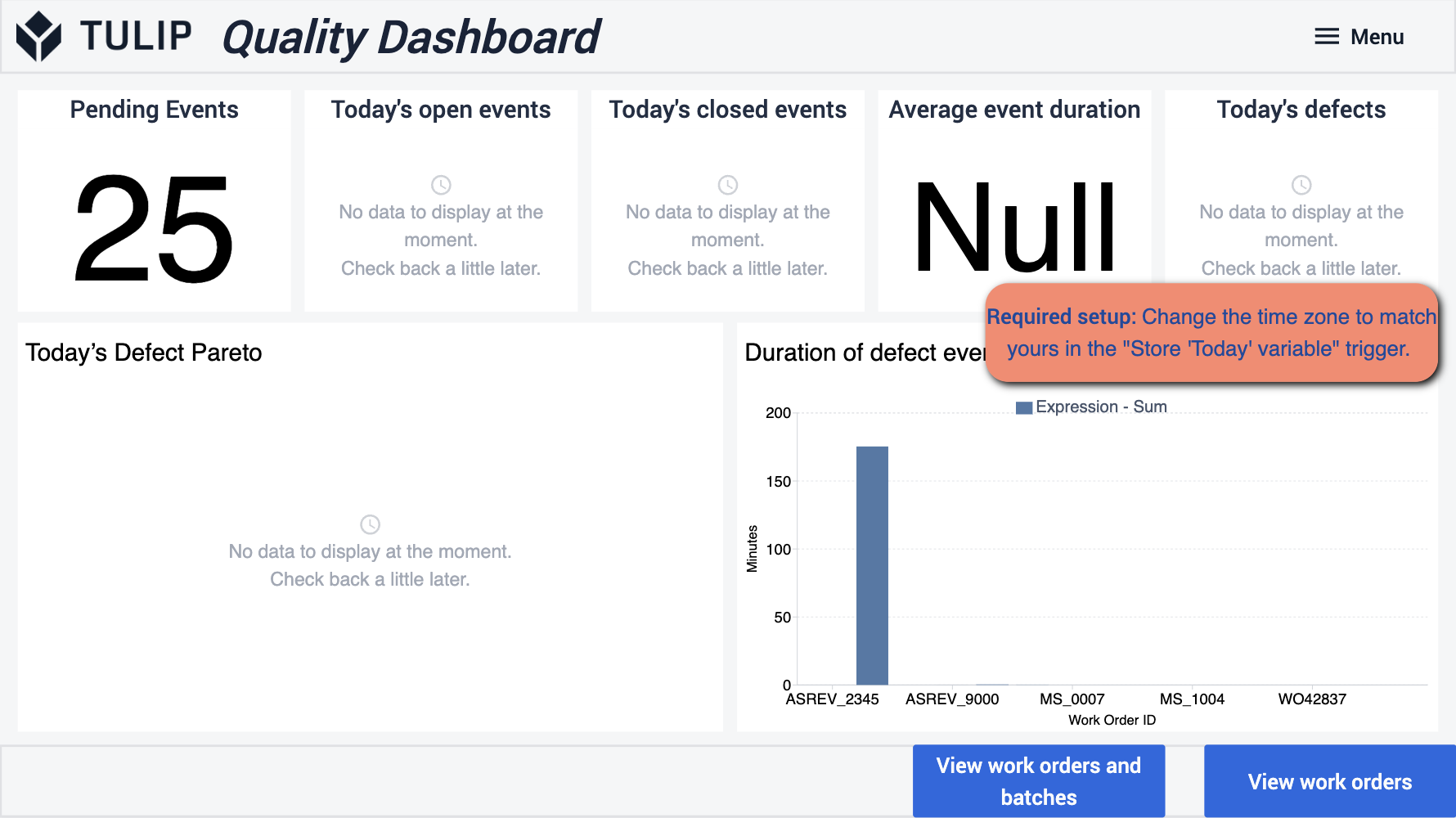 {height="300 "width=""}*此应用程序的必要设置是确保更改时区,使其与您的操作相匹配,以便进行正确跟踪。
{height="300 "width=""}*此应用程序的必要设置是确保更改时区,使其与您的操作相匹配,以便进行正确跟踪。
查看检测结果--批次
在可视化检验部分,您可以查看特定订单的详细信息。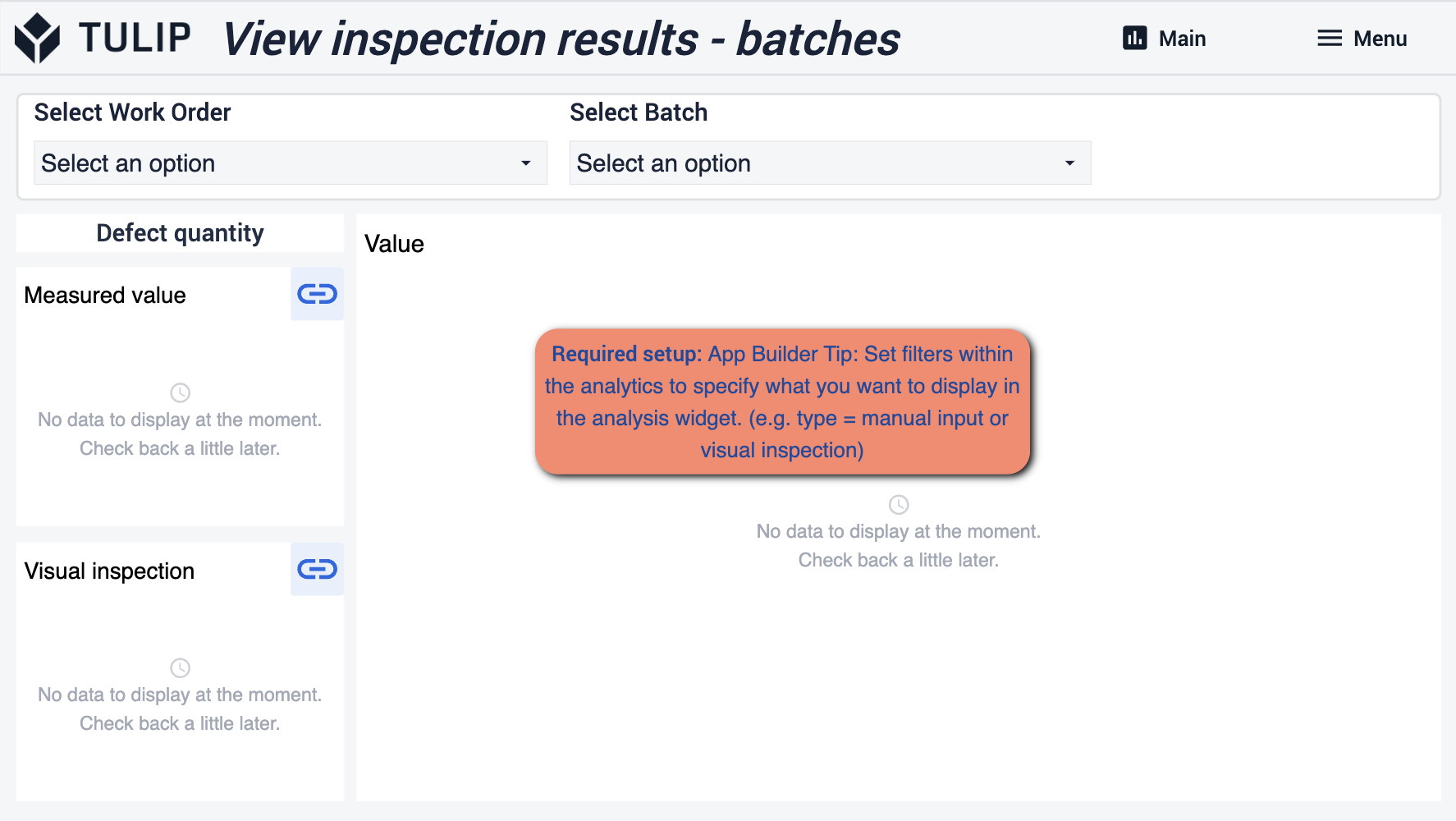 {height="300" width=""}*这里所需的设置主要是根据您希望看到的特定分析结果设置过滤器。图表类型以及图表要显示的指标。
{height="300" width=""}*这里所需的设置主要是根据您希望看到的特定分析结果设置过滤器。图表类型以及图表要显示的指标。
查看检查结果-工作
该视图重点关注工单和几种不同的分析方法。这里也需要遵循相同的提示。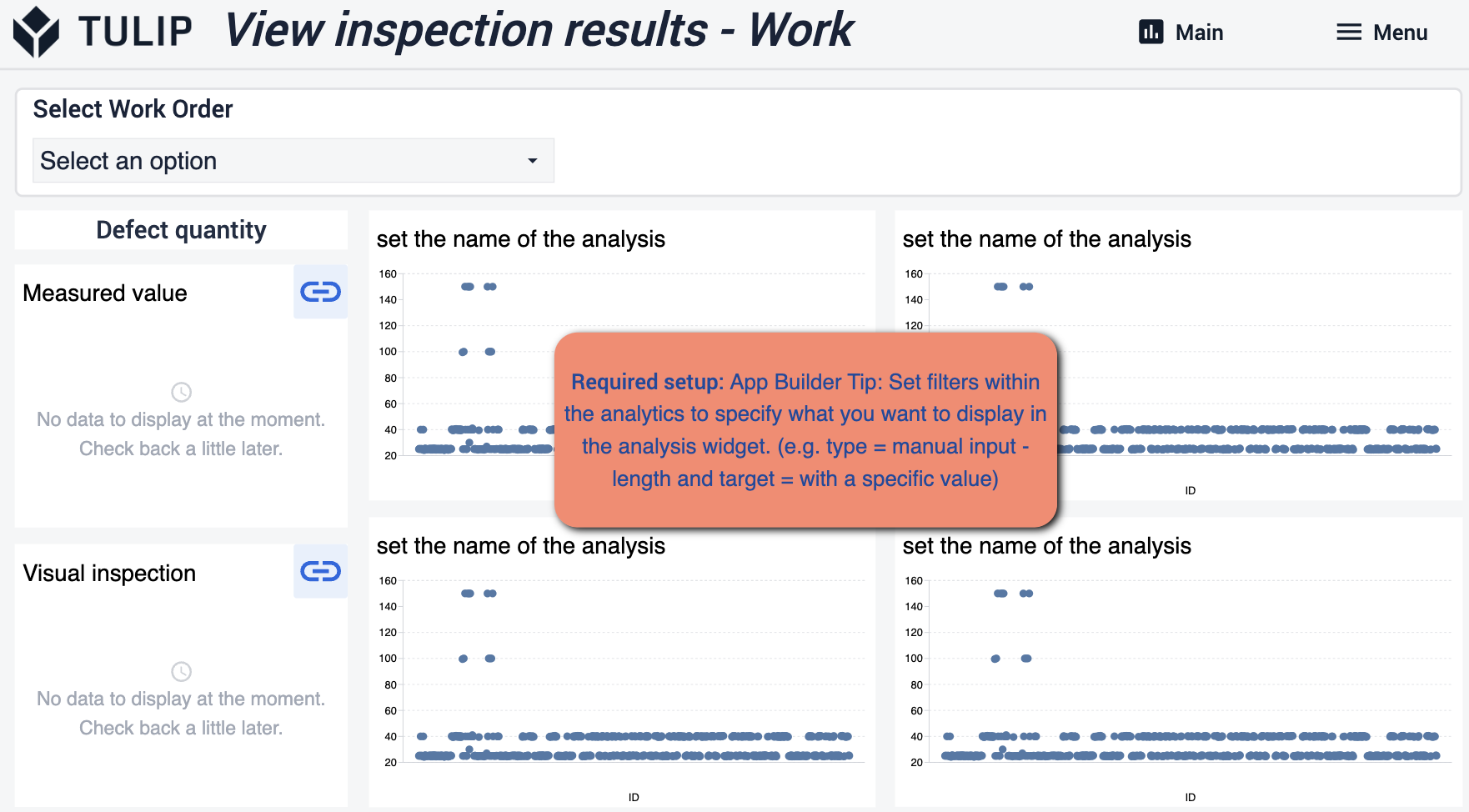
措施值结果
在这里,您将看到工单历史的详细信息。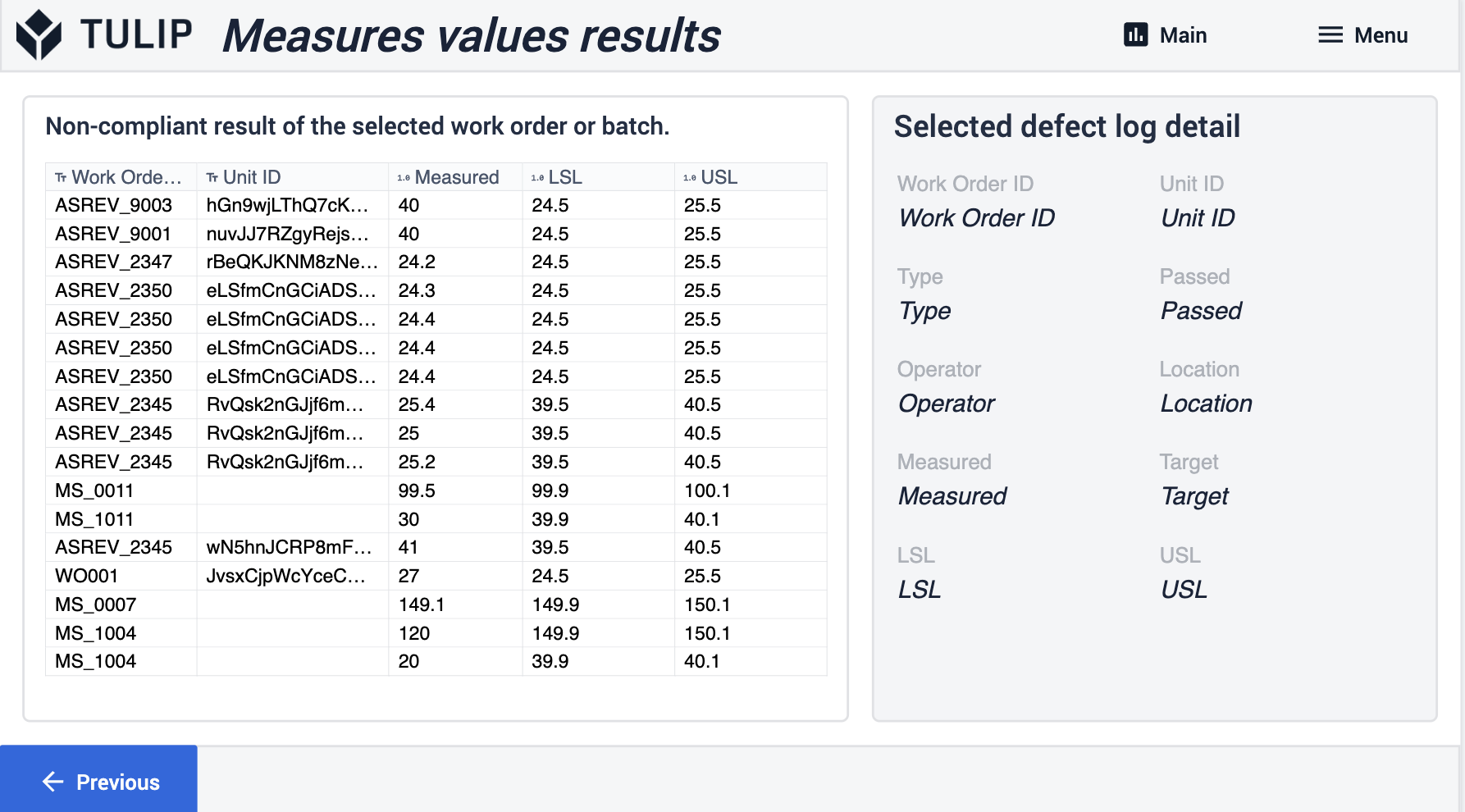 {height="300" width=""} 可视化检查结果
{height="300" width=""} 可视化检查结果
目视检查结果
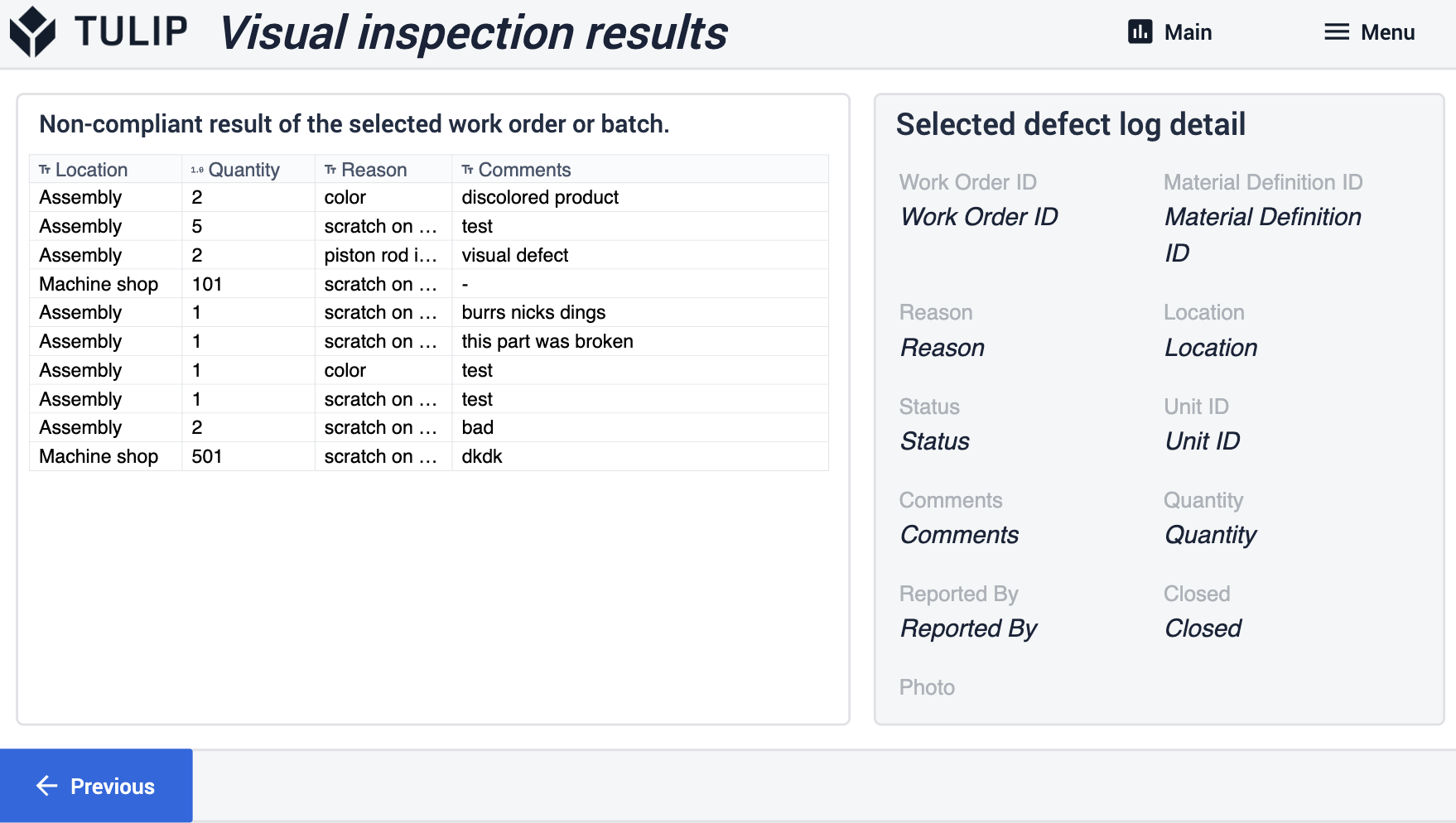
质量检查模板
完整的检查步骤组模板
查看批次
此步骤旨在让您查看已通过生产的所有可用批次。显示此工单历史的具体详细信息。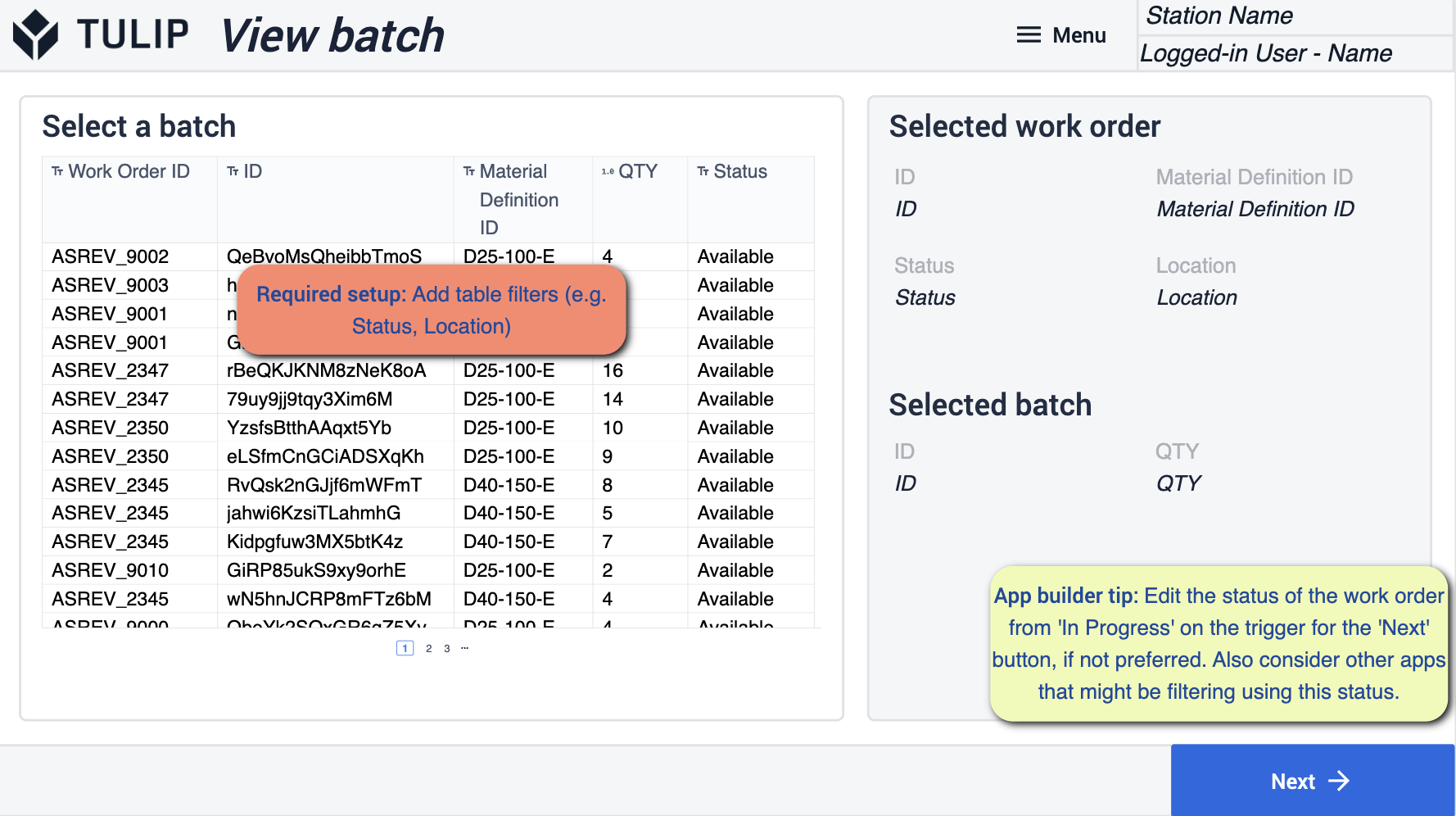 {height="300" width=""}* 确保添加表格筛选器以匹配您的操作。您需要通过下一个按钮的触发器将工单状态编辑为 "进行中"。
{height="300" width=""}* 确保添加表格筛选器以匹配您的操作。您需要通过下一个按钮的触发器将工单状态编辑为 "进行中"。
目视检查(模板)
该模板用于在产品通过时进行目视验收。订单将根据您添加到此特定步骤的图片参考通过或失败。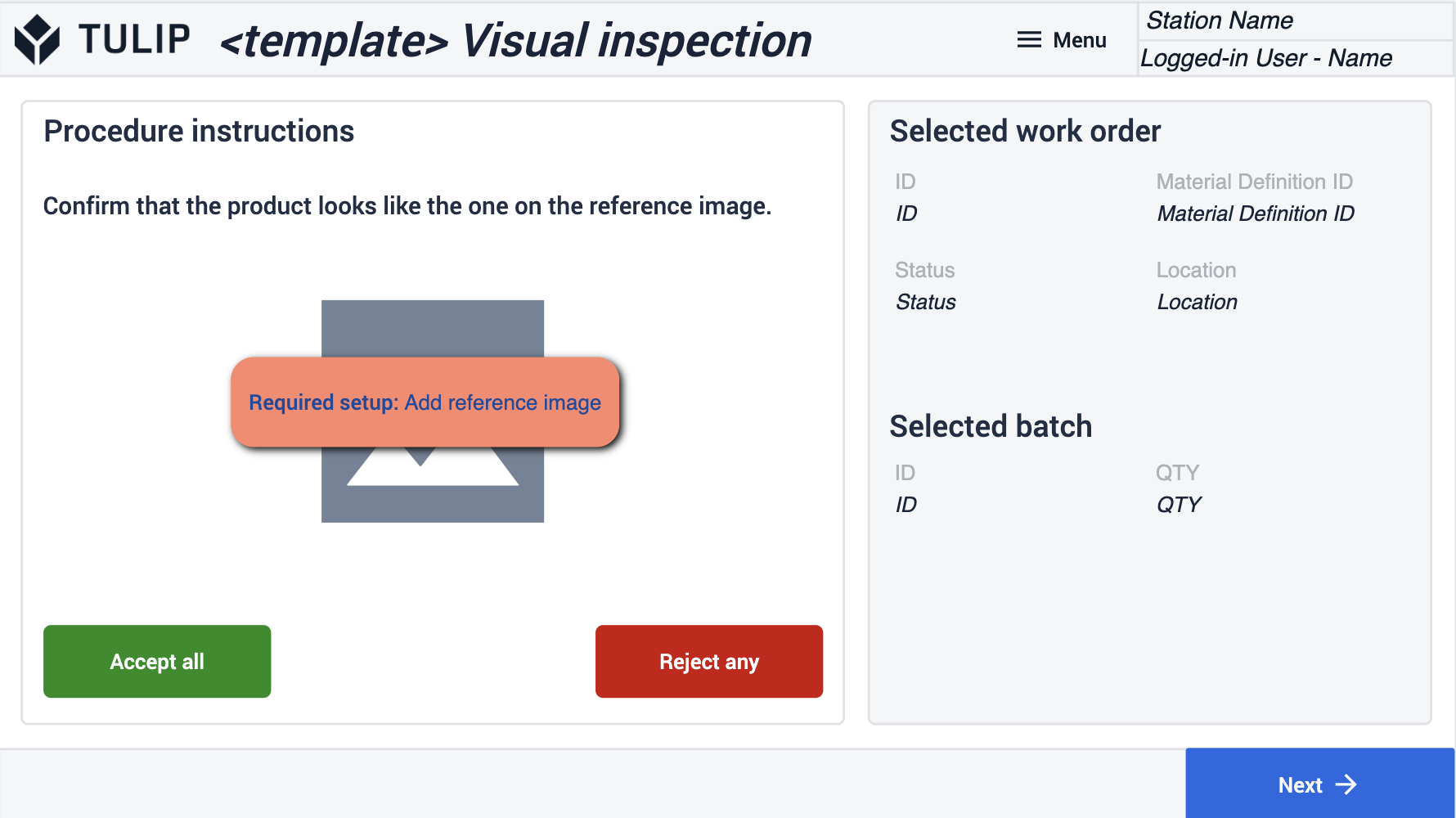 {height="300" width=""}* 确保添加通过检查的订单的视觉效果。
{height="300" width=""}* 确保添加通过检查的订单的视觉效果。
手动值输入(模板)
该模板与测量设备配对使用,用于捕捉订单通过检验时的设定参数。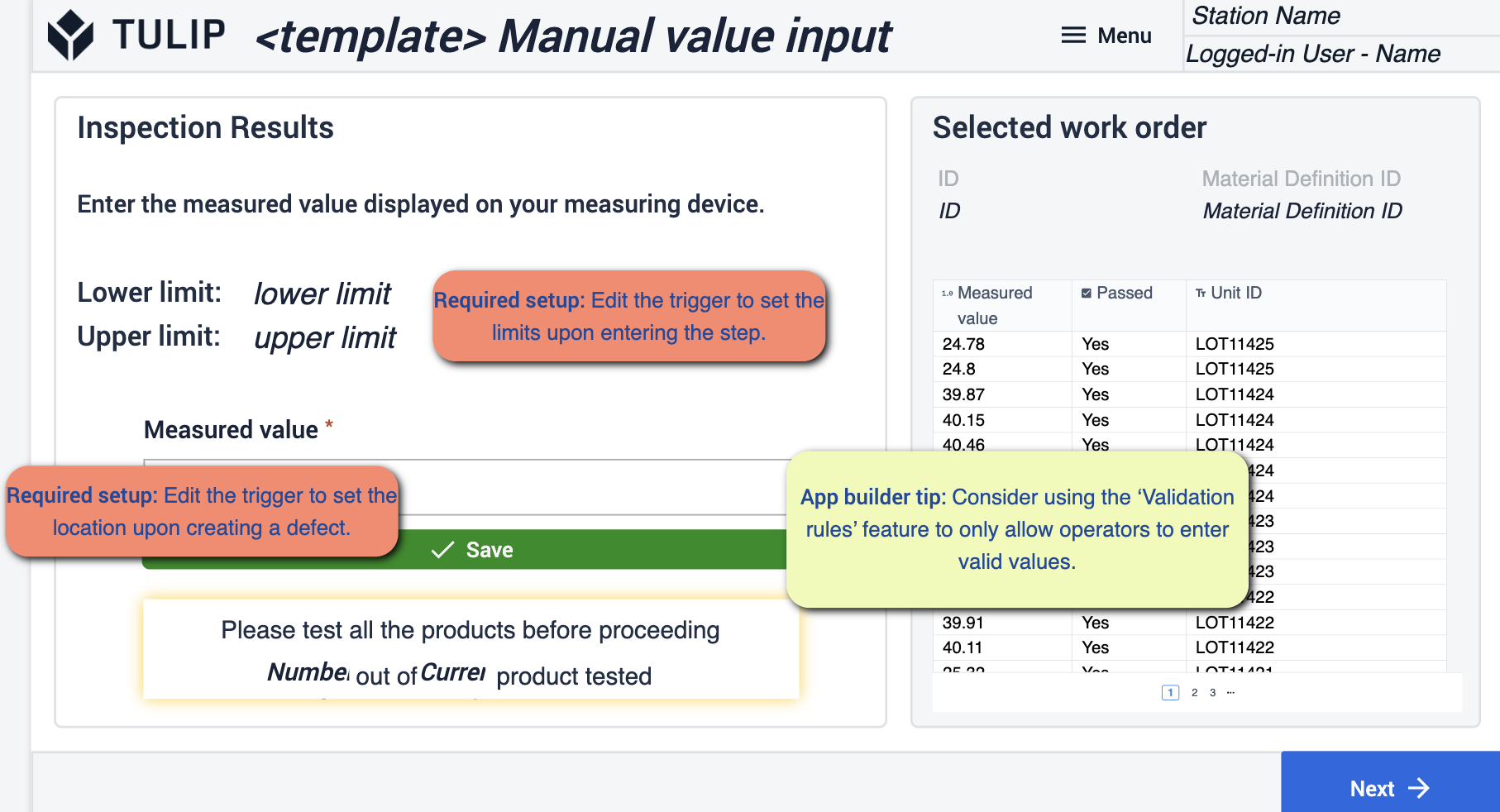
- 确保编辑触发器以遵循您为通过检测而设置的限制,并编辑触发器以捕获记录缺陷时的位置。
查看结果摘要
在这里,您将查看已通过检查的订单。您可以对所选订单进行一些调整。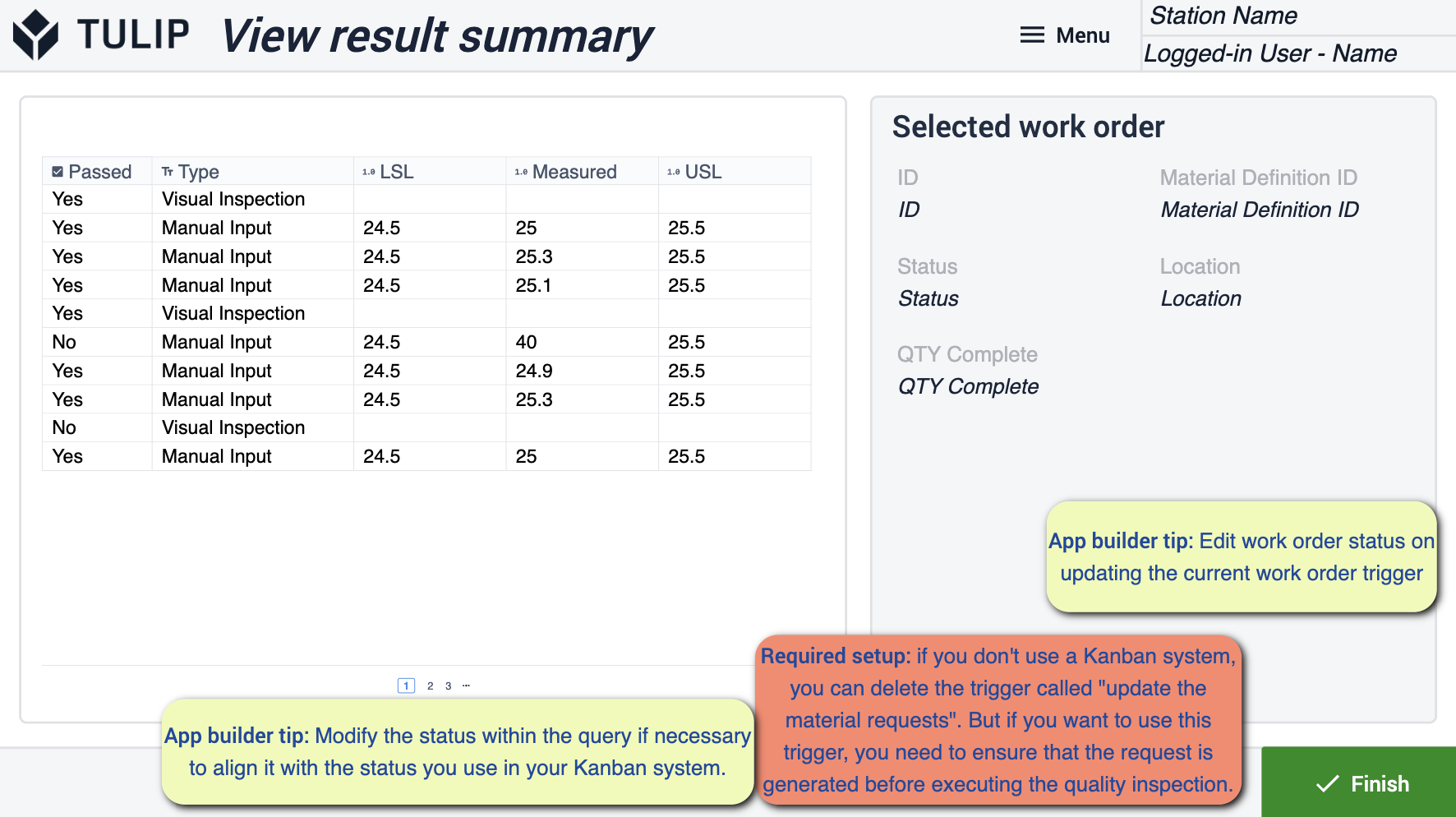 {height="300" width=""}* 通过相关触发器编辑工单规约和位置。
{height="300" width=""}* 通过相关触发器编辑工单规约和位置。
记录缺陷
在此步骤中,您将记录通过检查发现的任何缺陷。这将创建一个记录,并允许您跟踪出现的缺陷。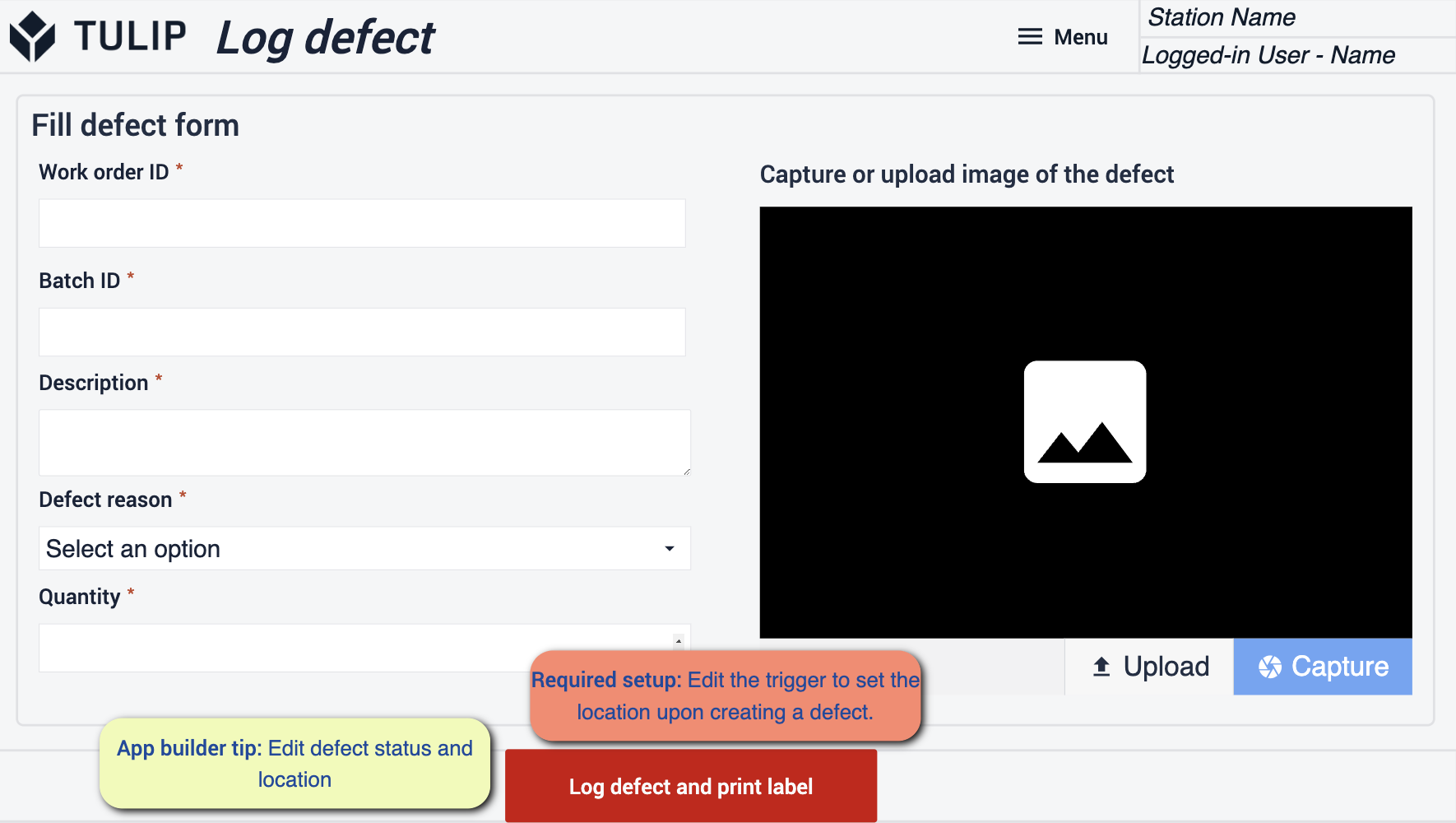 {height="300" width=""}*确保在应用程序中编辑缺陷状态和位置,以符合您的操作。在记录缺陷时,您必须编辑触发器以设置位置。
{height="300" width=""}*确保在应用程序中编辑缺陷状态和位置,以符合您的操作。在记录缺陷时,您必须编辑触发器以设置位置。
抽样检查步骤组模板
查看工单
您可以查看所有收到的工单,并选择要处理的工单或查看其历史记录。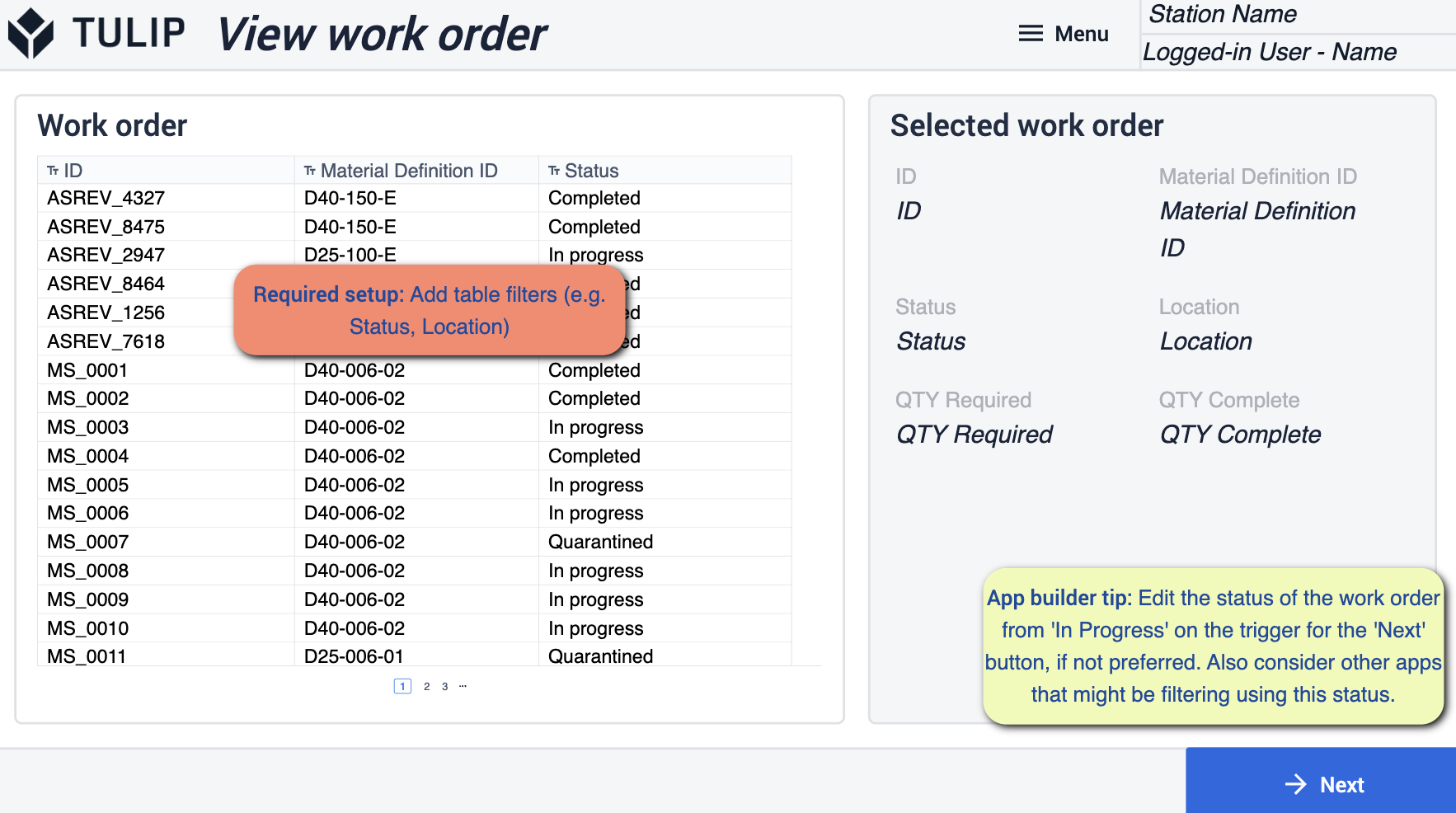 {height="300" width=""}* 确保筛选出与您的操作相匹配的表格。您需要通过与 "下一步 "按钮绑定的触发器来编辑工单状态。
{height="300" width=""}* 确保筛选出与您的操作相匹配的表格。您需要通过与 "下一步 "按钮绑定的触发器来编辑工单状态。
取样说明(模板)
该模板旨在为您提供指导,以便您在处理选定工单时遵循。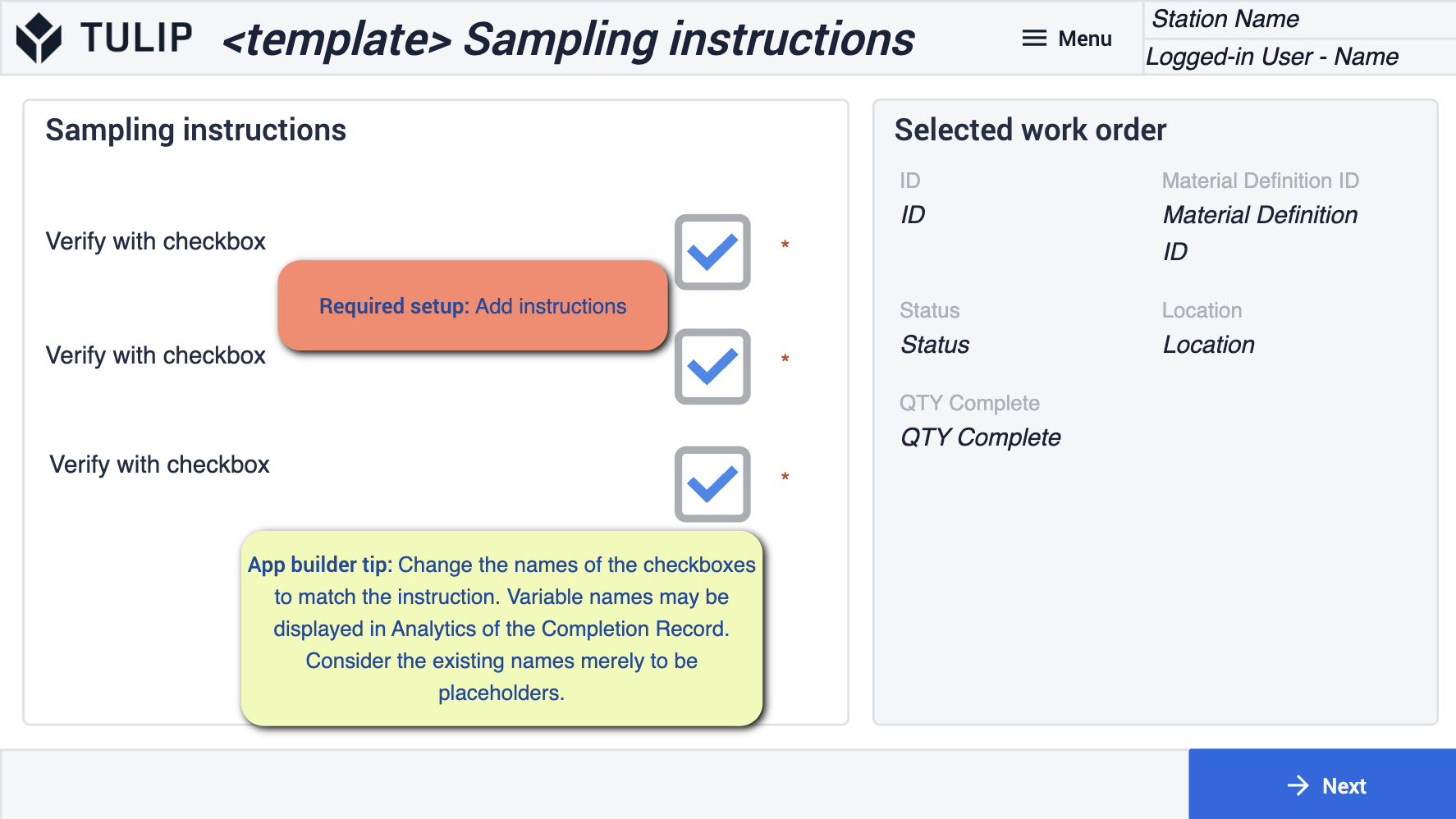 {height="300" width=""}* 确保添加的说明与操作员将要做的工作相匹配。您还需要确保更改复选框的名称,使其与您要捕获的分析内容相匹配。
{height="300" width=""}* 确保添加的说明与操作员将要做的工作相匹配。您还需要确保更改复选框的名称,使其与您要捕获的分析内容相匹配。
视觉检查(模板)
该模板用于在产品通过时进行目视验收。订单将根据您添加到此特定步骤的图片参考通过或失败。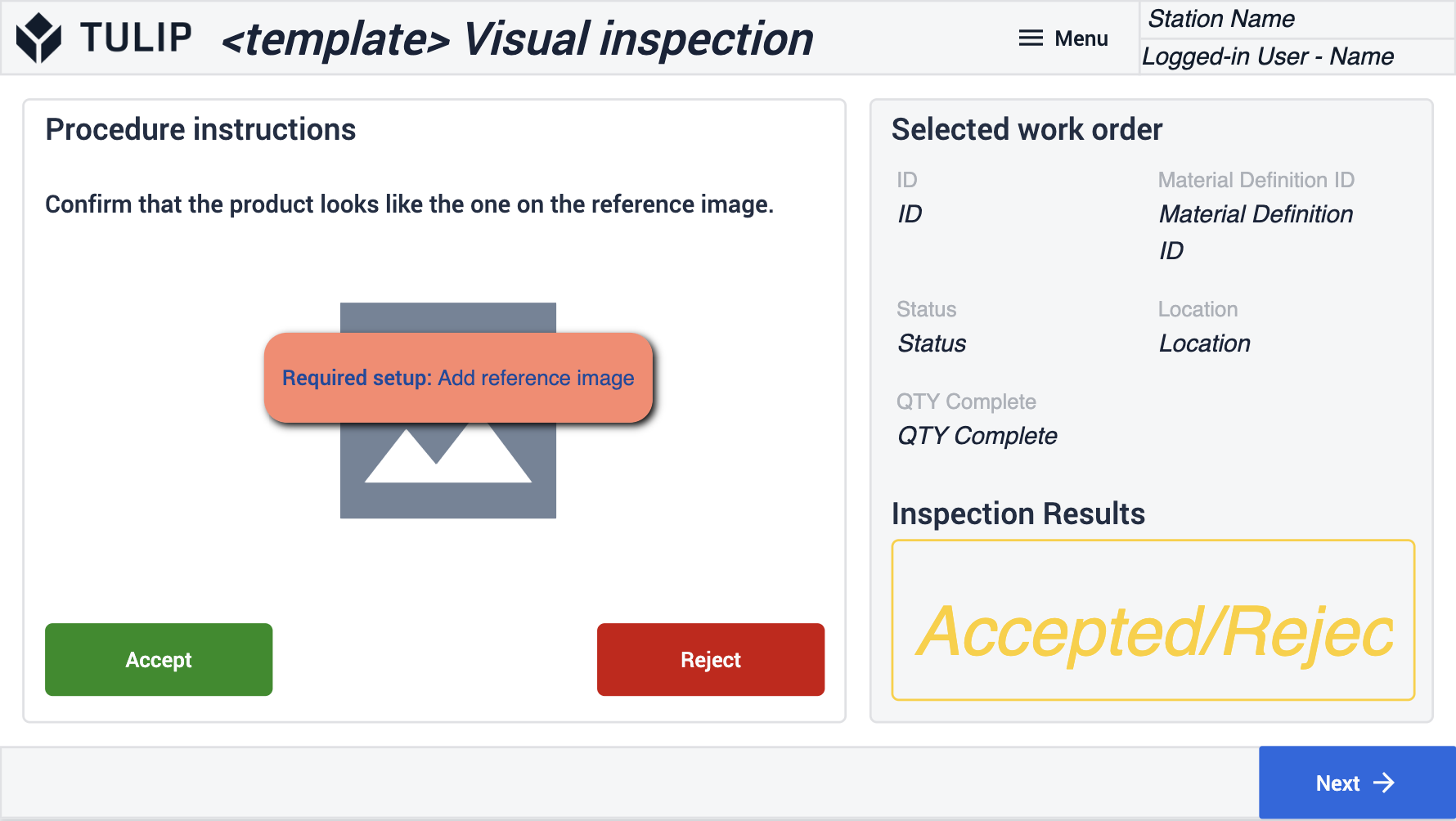 {height="300" width=""}* 确保添加通过检查的订单的视觉效果。
{height="300" width=""}* 确保添加通过检查的订单的视觉效果。
手动值输入(模板)
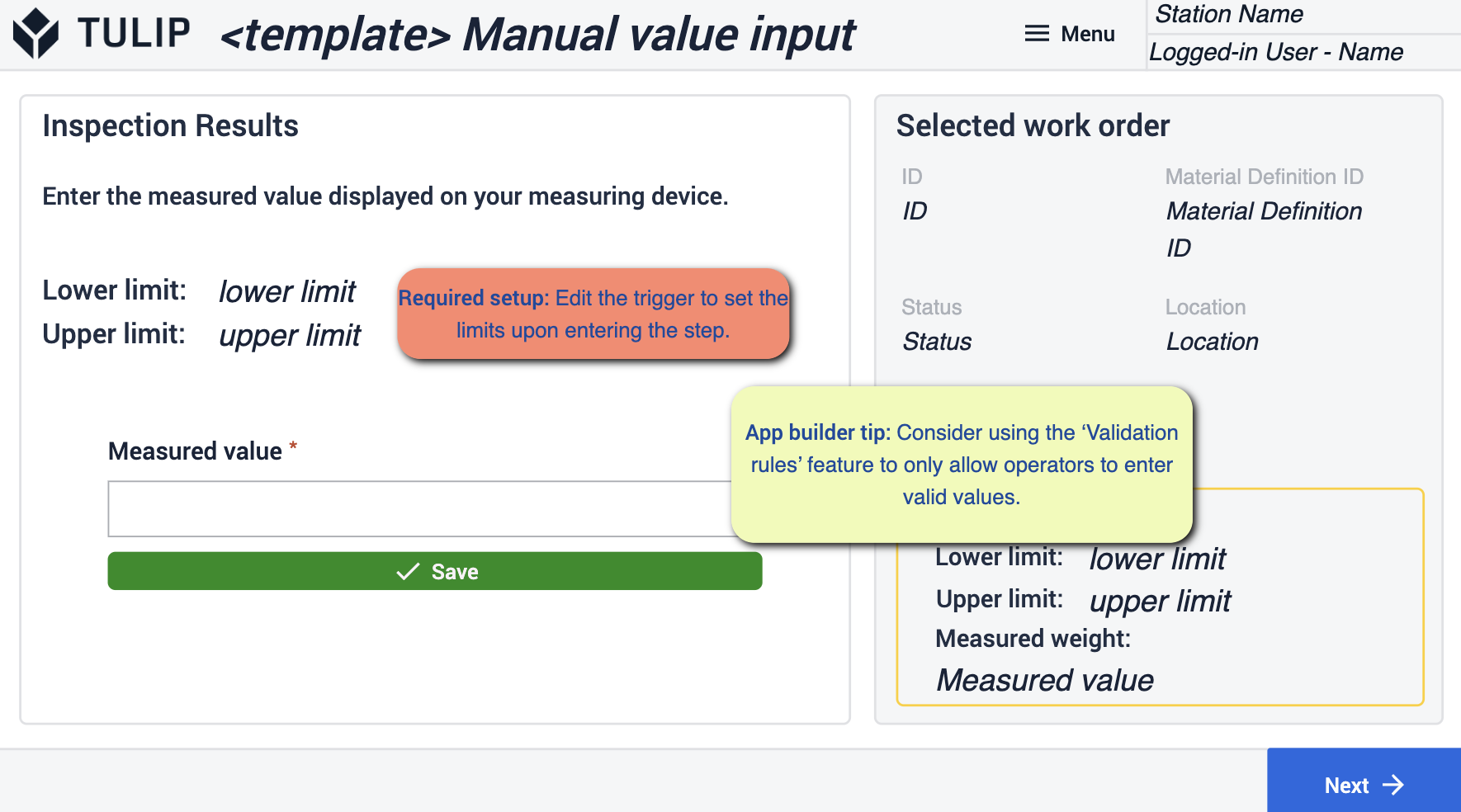 {height="300" width=""}*确保编辑触发器以遵循您为通过设置的限制,并编辑触发器以捕获记录缺陷时的位置。
{height="300" width=""}*确保编辑触发器以遵循您为通过设置的限制,并编辑触发器以捕获记录缺陷时的位置。
查看结果摘要
您将在此查看已通过检查的订单。您可以对所选订单进行一些调整。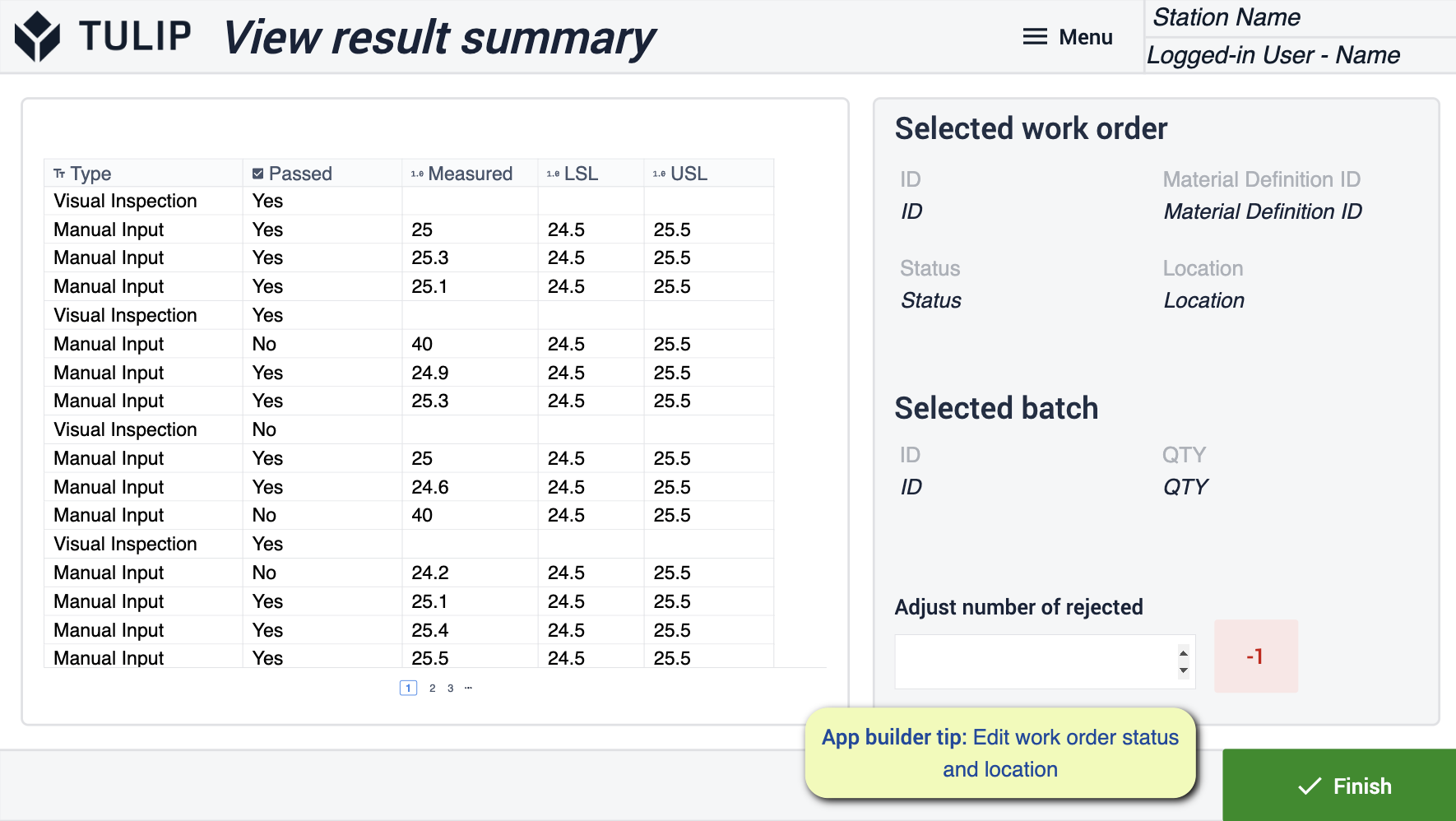 {height="300" width="""}* 通过相关触发器编辑工单状态和位置。如果不使用看板系统,请按照步骤删除材料申请触发器。如果计划使用,请确保您的状态与看板系统中的状态一致。
{height="300" width="""}* 通过相关触发器编辑工单状态和位置。如果不使用看板系统,请按照步骤删除材料申请触发器。如果计划使用,请确保您的状态与看板系统中的状态一致。
记录缺陷
在此步骤中,您将记录通过检查发现的任何缺陷。这将创建一个记录,以便您跟踪出现的缺陷。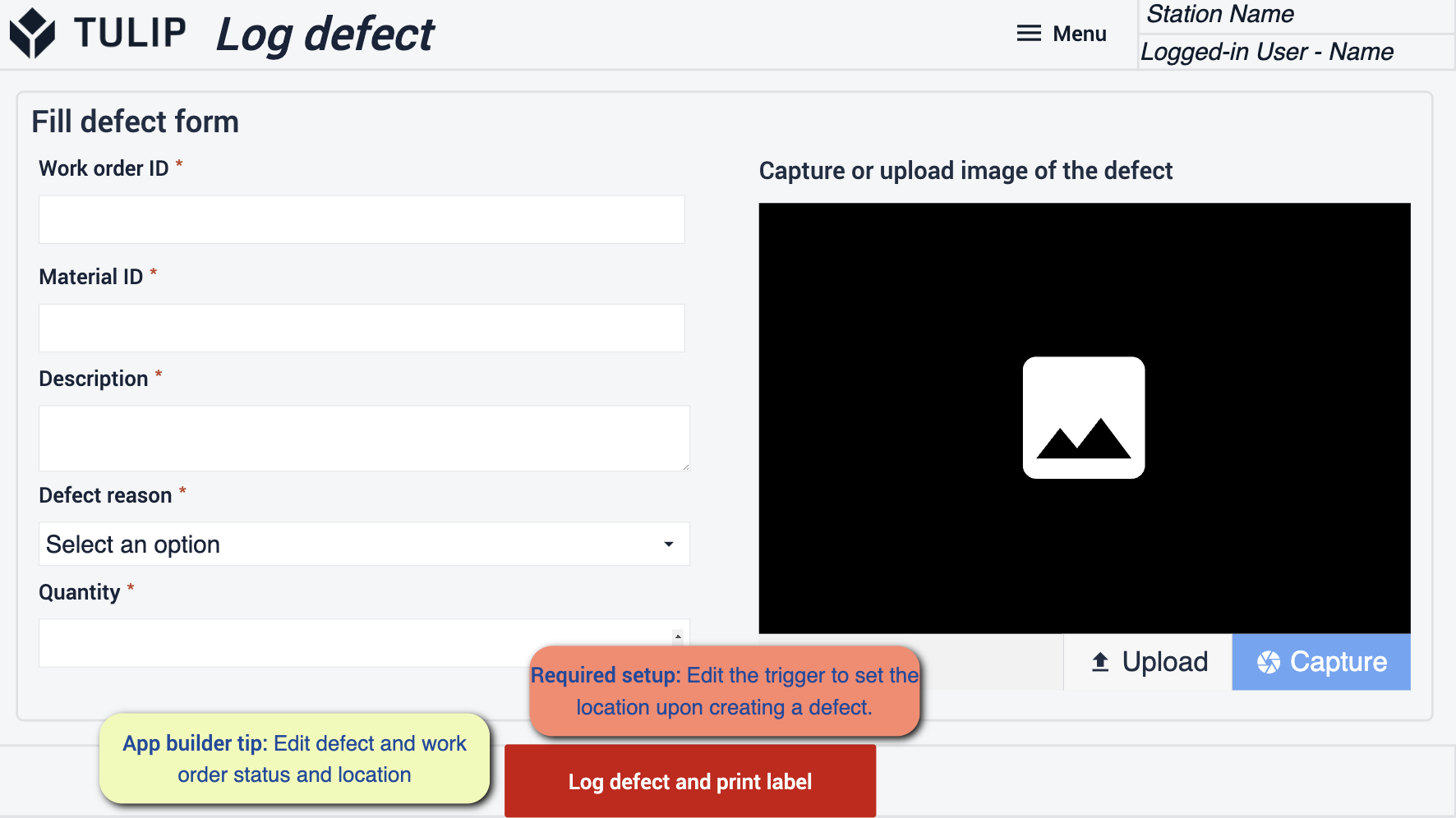 {height="300" width=""}* 确保在应用程序中编辑缺陷状态和位置,以符合您的操作。在记录缺陷时,您必须编辑触发器以设置位置。
{height="300" width=""}* 确保在应用程序中编辑缺陷状态和位置,以符合您的操作。在记录缺陷时,您必须编辑触发器以设置位置。
标签
创建一个标签,在操作员完成操作后显示订单的历史记录。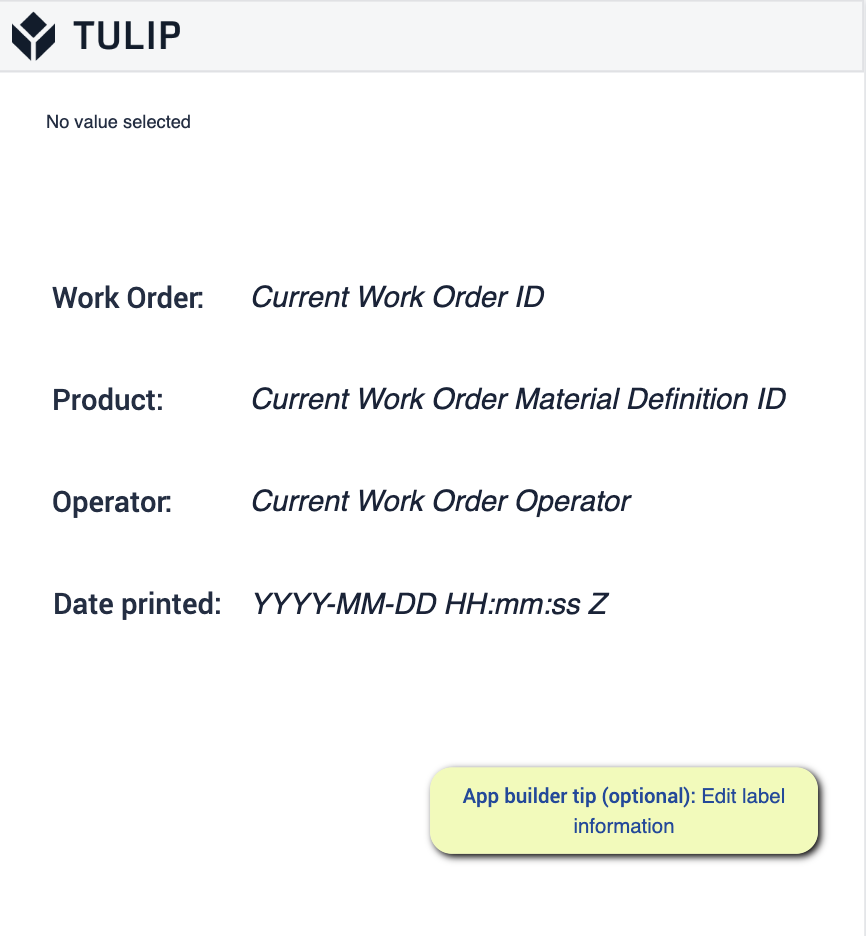
- 您可以编辑标签,显示需要显示的信息。
准备就绪
在使用应用程序套件时,确保遵循 "应用程序生成器提示 "非常重要。这些提示将指导您为部署应用程序做好准备。请务必参考先决条件,并确保在每个步骤中都遵循了 "必备步骤 "和 "应用程序生成器提示"。